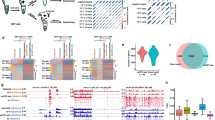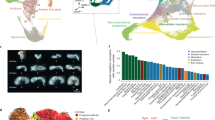Abstract
Symmetric cell divisions give rise to two sister cells that are identical to each other, whereas asymmetric divisions produce two sister cells with distinctive phenotypes. Although cell division symmetry is usually determined on the basis of a few markers or biological functions, the overall similarity between sister cells has not been thoroughly examined at a molecular level. Here we provide a protocol to separate sister embryonic stem cells (ESCs) and to conduct multiplexed gene expression analyses at the single-cell level by using 48 ESC genes. The procedure includes the dissection of dividing, paired sister cells by micromanipulation, followed by cell lysis, reverse transcription, gene-specific cDNA amplification and multiplexed quantitative PCR analyses. This protocol can be completed in 10 d, and it can be readily adapted to other cell types that are able to grow in suspension culture.
This is a preview of subscription content, access via your institution
Access options
Subscribe to this journal
Receive 12 print issues and online access
$259.00 per year
only $21.58 per issue
Buy this article
- Purchase on Springer Link
- Instant access to full article PDF
Prices may be subject to local taxes which are calculated during checkout


Similar content being viewed by others
References
Suda, T., Suda, J. & Ogawa, M. Single-cell origin of mouse hemopoietic colonies expressing multiple lineages in variable combinations. Proc. Natl. Acad. Sci. USA 80, 6689–6693 (1983).
Brummendorf, T.H., Dragowska, W., Zijlmans, J., Thornbury, G. & Lansdorp, P.M. Asymmetric cell divisions sustain long-term hematopoiesis from single-sorted human fetal liver cells. J. Exp. Med. 188, 1117–1124 (1998).
Ema, H., Takano, H., Sudo, K. & Nakauchi, H. In vitro self-renewal division of hematopoietic stem cells. J. Exp. Med. 192, 1281–1288 (2000).
Wu, M. et al. Imaging hematopoietic precursor division in real time. Cell Stem Cell 1, 541–554 (2007).
Beckmann, J., Scheitza, S., Wernet, P., Fischer, J.C. & Giebel, B. Asymmetric cell division within the human hematopoietic stem and progenitor cell compartment: identification of asymmetrically segregating proteins. Blood 109, 5494–5501 (2007).
Muramoto, T., Muller, I., Thomas, G., Melvin, A. & Chubb, J.R. Methylation of H3K4 Is required for inheritance of active transcriptional states. Curr. Biol. 20, 397–406 (2010).
Zwaka, T.P. & Thomson, J.A. Differentiation of human embryonic stem cells occurs through symmetric cell division. Stem Cells 23, 146–149 (2005).
Huang, S., Law, P., Francis, K., Palsson, B.O. & Ho, A.D. Symmetry of initial cell divisions among primitive hematopoietic progenitors is independent of ontogenic age and regulatory molecules. Blood 94, 2595–2604 (1999).
Punzel, M., Zhang, T., Liu, D., Eckstein, V. & Ho, A.D. Functional analysis of initial cell divisions defines the subsequent fate of individual human CD34+CD38− cells. Exp. Hematol. 30, 464–472 (2002).
Yamamoto, R. et al. Clonal analysis unveils self-renewing lineage-restricted progenitors generated directly from hematopoietic stem cells. Cell 154, 1112–1126 (2013).
Jasnos, L., Aksoy, F.B.l., Hersi, H.M., Wantuch, S. & Sawado, T. Identifying division symmetry of mouse embryonic stem cells: negative impact of DNA methyltransferases on symmetric self-renewal. Stem Cell Rep. 1, 360–369 (2013).
Kantlehner, M. et al. A high-throughput DNA methylation analysis of a single cell. Nucleic Acids Res. 39, e44 (2011).
Tang, F. et al. Tracing the derivation of embryonic stem cells from the inner cell mass by single-cell RNA-seq analysis. Cell Stem Cell 6, 468–478 (2010).
Tang, F. et al. RNA-seq analysis to capture the transcriptome landscape of a single cell. Nat. Protoc. 5, 516–535 (2010).
Zong, C., Lu, S., Chapman, A.R. & Xie, X.S. Genome-wide detection of single-nucleotide and copy-number variations of a single human cell. Science 338, 1622–1626 (2012).
Potter, N.E. et al. Single cell mutational profiling and clonal phylogeny in cancer. Genome Res. 23, 2115–2125 (2013).
Shi, Q. et al. Single-cell proteomic chip for profiling intracellular signaling pathways in single tumor cells. Proc. Natl. Acad. Sci. USA 109, 419–424 (2012).
Ying, Q.L., Nichols, J., Chambers, I. & Smith, A. BMP induction of Id proteins suppresses differentiation and sustains embryonic stem cell self-renewal in collaboration with STAT3. Cell 115, 281–292 (2003).
Ying, Q.L. et al. The ground state of embryonic stem cell self-renewal. Nature 453, 519–523 (2008).
Mohamet, L., Lea, M.L. & Ward, C.M. Abrogation of E-cadherin-mediated cellular aggregation allows proliferation of pluripotent mouse embryonic stem cells in shake flask bioreactors. PLoS ONE 5, e12921 (2010).
Lei, H. et al. De novo DNA cytosine methyltransferase activities in mouse embryonic stem cells. Development 122, 3195–3205 (1996).
Okano, M., Bell, D.W., Haber, D.A. & Li, E. DNA methyltransferases Dnmt3a and Dnmt3b are essential for de novo methylation and mammalian development. Cell 99, 247–257 (1999).
Pradhan, S., Bacolla, A., Wells, R.D. & Roberts, R.J. Recombinant human DNA (cytosine-5) methyltransferase. I. Expression, purification, and comparison of de novo and maintenance methylation. J. Biol. Chem. 274, 33002–33010 (1999).
Pradhan, S. et al. Baculovirus-mediated expression and characterization of the full-length murine DNA methyltransferase. Nucleic Acids Res. 25, 4666–4673 (1997).
Okano, M., Xie, S. & Li, E. Cloning and characterization of a family of novel mammalian DNA (cytosine-5) methyltransferases. Nat. Genet. 19, 219–220 (1998).
Tsumura, A. et al. Maintenance of self-renewal ability of mouse embryonic stem cells in the absence of DNA methyltransferases Dnmt1, Dnmt3a and Dnmt3b. Genes Cells 11, 805–814 (2006).
Leitch, H.G. et al. Naive pluripotency is associated with global DNA hypomethylation. Nat. Struct. Mol. Biol. 20, 311–316 (2013).
Acknowledgements
This work was supported by funding from the ICR. We thank S. Wantuch for technical assistance, T. Chen (M.D. Anderson Cancer Center) and M. Okano (Riken) for providing J1 WT and DKO embryonic stem cells, respectively, and L. Kearney, T. Ford and N. Potter (ICR) for critical reading and discussion.
Author information
Authors and Affiliations
Contributions
L.J. performed experiments, analyzed data and wrote the paper. T.S. conceived, designed and performed experiments, analyzed data and wrote the paper.
Corresponding author
Ethics declarations
Competing interests
The authors declare no competing financial interests.
Supplementary information
Supplementary Table 1
Sequence of all primers used in the experiment. (XLSX 49 kb)
Supplementary Table 2
Biomark qPCR expression data. (XLSX 98 kb)
Microdissection of dividing sister cells.
1 s: the micropipette is placed above the paired sister cells. 9 s: the micropipette exerts physical pressure onto the junction between sister cells. 12 s: the temperature of the air trapped in the pipette decreases. 39 s: the low pressure in the pipette traps one of the sister cells. 45 s: the cell is transferred to a glass slide (the ejection part is not shown in this movie) 53 s: the pipette returns to the original picking position. 56 s: the other sister cell is picked. Bar, 20 μm. (MOV 501 kb)
Rights and permissions
About this article
Cite this article
Jasnos, L., Sawado, T. Determining cell division symmetry through the dissection of dividing cells using single-cell expression analysis. Nat Protoc 9, 505–516 (2014). https://doi.org/10.1038/nprot.2014.032
Published:
Issue Date:
DOI: https://doi.org/10.1038/nprot.2014.032
Comments
By submitting a comment you agree to abide by our Terms and Community Guidelines. If you find something abusive or that does not comply with our terms or guidelines please flag it as inappropriate.



